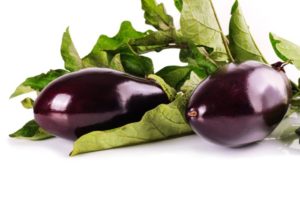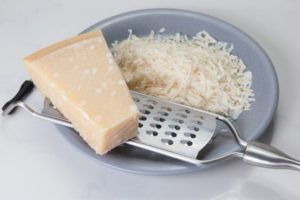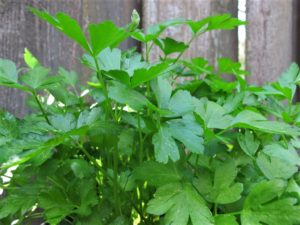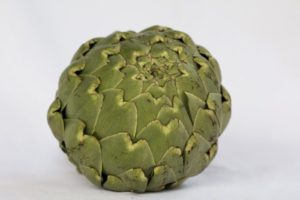Updated 1/20/2024
Eggplant Parmigiana
One of the favorite dishes from our kitchen is Eggplant Parmigiana. First, I have to admit that I never use Parmesan. Locatelli Romano is our preferred cheese for Italian dishes. Purchased as a solid wedge, and grated in batches, it’s always on hand in the refrigerator.
As a kid, I would “borrow” a chunk of Romano from my Sicilian grandmother’s kitchen, and hide under the table where I could savor every little bite. Mmm….so good!
Over the years, I’ve tried many recipes for Eggplant Parmigiana, but it wasn’t until last year that I came up with this combination. An organized kitchen is helpful as this dish is being orchestrated. And having some potted herbs outside the kitchen door is very handy.
Have These Ready
- one 13″x 9″ Pyrex baking dish, or other dish that can take low heat from the stovetop, and oven heat
- 2 non-stick frying pans, medium to large, for eggplant
- separate bowls to hold zucchini and eggplant slices
- pie plate for eggs and water
- wide bowl for bread crumbs
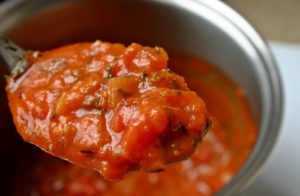
Ingredients
- 1 or 2 small zucchini, yellow or green, unpeeled, cut into 1/4″ slices
- 2 medium (less seedy than large) fresh eggplants, unpeeled, cut lengthwise into 1/4″ slices (no need to “bleed” out moisture)
- Your favorite meatless tomato sauce
- 2 cups or more seasoned bread crumbs; see below
- 2 eggs plus 1 Tbsp. water, stirred together in pie plate
- Extra virgin olive oil
- butter
- 1 lb. mozzarella cheese, sliced
- About 3/4 lb. Provolone cheese, thinly sliced
- 1 to 1 1/2 cups Romano cheese, grated
- 1 or 2 cups wilted greens, such as spinach, arugula, Swiss chard, and dinosaur kale. Or use 1 or 2 bags of prepared greens. Greens are optional, but recommended. You can also use fresh greens.
Bread Crumbs—Ingredients
Mix together all these ingredients in the bowl:
-
Several slices dry rye, whole wheat, and/or white bread, processed to medium-fine crumbs. I collect odds and ends in an open bag in the refrigerator, letting them dry.
- 1/2 to 2/3 cup grated Romano cheese
- 2 or 3 cloves fresh garlic, minced
- 3 Tbsp. fresh flat leaf parsley, chopped
- 1 Tbsp. fresh or 1-1 ½ tsp. dry Italian oregano
- 1/2 tsp. salt, or to taste
- 1/4 tsp. pepper, or to taste
- 1/4 tsp. thyme, French preferred
The Process
- Place baking dish on small burner of stove. Add a layer of sauce to coat the bottom of the pan.
- Add zucchini slices close together in single layer, on top of sauce in baking dish. Turn on stove to very low heat, which will begin softening the zucchini as eggplant is being prepared. Move the pan around so no spots overheat. Turn over zucchini slices once for even heating. Make sure your dish will be safe to use like this. (If you prefer not to heat the pan, add some time when baking the eggplant.)
- In frying pans, add olive oil and a little bit of butter. Not too much.
- One slice at a time, dip eggplant in egg bath, then press into bread crumbs, coating both sides.
- Add breaded eggplant slices to frying pans (I use 2 pans to speed up the process), and sauté over medium heat until medium brown. Don’t use high heat; this will brown the bread crumbs, leaving eggplant raw.
- Place cooked eggplant slices close together, in a single layer on top of zucchini, into baking dish.
- Continue sautéing eggplant slices, adding oil and butter as needed. While the next batch is cooking, add a layer of Romano, mozzarella, and Provolone cheeses, and more sauce, to the baking dish.
- Add the greens in the middle layers.
Continue Layering
- Continue layering eggplant, cheeses, and sauce until dish is filled. Usually there are 2 or 3 layers of eggplant. You can add leftover egg and bread crumbs, finishing with sauce.
- Drizzle 1 or 2 Tbsp. olive oil over the top, plus a couple of pinches of oregano.
- Bake at 350 degrees, loosely covered with foil. If the pan is filled to the top, place an old cookie sheet on the bottom rack to catch the spillover. If sauce is watery, lower heat, loosen foil, and cook a bit longer.
- It’s done when sauce is gently bubbling all over, usually 40 to 50 minutes.
- Serve with extra grated Romano cheese and sauce, if needed.
Wasn’t that easy? Maybe not the first time, but it is delicious! Serve with some good bread and a green salad or tomato-basil salad. Maybe some wine…good company…and…
…Stuffed Artichokes
Snip the points off the artichoke leaves, remove the smallest bottom leaves, trim the stem to an inch or so, rinse, and drain.
Use the bread crumb recipe above, adding more Romano cheese, salt, and garlic. Place the artichoke in the bowl of bread crumbs and spoon the mixture between the leaves. Use your fingers to firm more crumbs between the leaves.
Place in artichoke holders and add 2 to 3 cups of water in a heavy stock pot. Drizzle olive oil, 2 or 3 Tbsp. water, and a dash of salt over the tops of the artichokes.
Using a covered stock pot, 2 well-stuffed large artichokes will need 2 to 3 hours on a low simmer to steam. Add water as necessary. They’re done when you can easily remove a large leaf. When you pull the leaf through your teeth, the green part is tender and will scrape off. (Artichoke greens are good for gut health.) Some prefer to use a pressure cooker, which speeds things up considerably.
Stuffed artichokes can be made ahead of time and reheated in the oven, covered with foil.
This dinner was a big hit when relatives came to town earlier this month. Enjoy!
